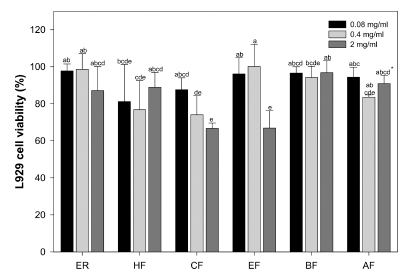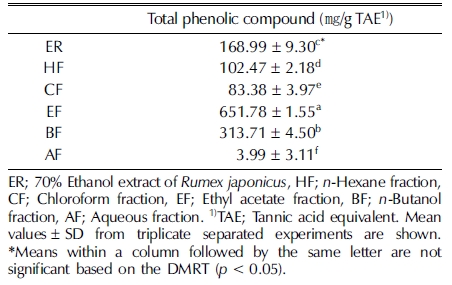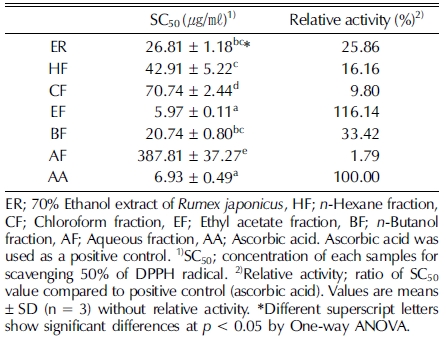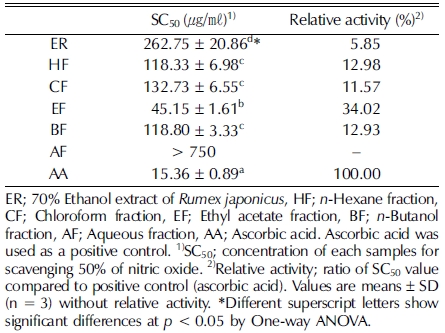
양제근 추출물 및 분획의 항산화 활성과 Tyrosinase 저해 활성
© The Korean Society of Medicinal Crop Science. All rights reserved.
This is an Open-Access article distributed under the terms of the Creative Commons Attribution Non-Commercial License ( http://creativecommons.org/licenses/by-nc/3.0 ) which permits unrestricted non-commercial use, distribution, and reproduction in any medium, provided the original work is properly cited.
Abstract
We investigated the antioxidative and tyrosinase inhibitory activities of 70% ethanol extract, and its fractions, of the root of Rumex japonicus HOUTT.
The total phenolic compound contents of the 70% ethanol extract and ethyl acetate fraction were 168.99㎎/g and 651.78㎎/g, respectively. The antioxidant activity was compared through the DPPH radical and nitric oxide (NO) scavenging assays. The ethyl acetate fraction showed the highest DPPH radical and NO scavenging abilities, which confirmed the antioxidant activity. Specifically, the ethyl acetate fraction showed a higher DPPH radical scavenging ability than ascorbic acid. These results were related to the total phenolic compound content of the ethyl acetate fraction. Moreover, in the tyrosinase inhibition assay, the ethyl acetate fraction exhibited stronger inhibitory activity than arbutin, which was used as the positive control. The cell viability of L929 cells was analyzed by MTT assay after treatment with 70% ethanol extract and all fractions; no changes in viability were observed, which demonstrated the nontoxic nature of the extract and fractions.
These results suggested that the extract from the root of R. japonicus and its ethyl acetate fraction could be a novel resource for the development of a cosmetic with antioxidant and tyrosinase inhibitory activity.
Keywords:
Rumex japonicus HOUTT, Antioxidative Activity, Cytotoxicity, Tyrosinase Inhibition서 언
피부는 자외선, 공해, 화학 산화제 및 미생물, 염증반응 등 과 같은 산화적 스트레스 요인의 공격에 노출되어 있다 (Rahimuddin et al., 2007). 특히 자외선의 노출로 인해 반응 성이 큰 활성산소종 (reactive oxygen species, ROS)이 생성되 고 이로 인해 광산화적 손상을 받게 된다 (Park, 2003). 이러 한 활성산소종에 의해 발생되는 손상을 억제하기 위해 높은 항 산화 활성 및 경제성 때문에 합성항산화제 (butylated hydroxy anisol, BHA; butylate hydroxy toluene, BHT)가 많이 이용 되어 왔으나 최근 안전성 논란으로 인하여 우수한 활성을 가 지며 안전성이 확보될 수 있는 천연 항산화제를 개발하기 위 한 연구가 활발히 진행되고 있다 (Frankel, 1996;Jung et al., 2004;Masaki et al., 1995;Shin, 1997).
현대 사회에서 성별과 나이에 상관없이 피부에 대한 관심도 가 높아지며 건강한 피부와 관련된 분야의 중요도가 높아졌다. 그 중에서도 피부미백에 관련된 연구는 tyrosinase 저해 활성, 항산화 활성, 자외선 차단 등이 주로 이루어지고 있다. 특히 피부색, 색소침착여부가 melanin의 양상에 따라 좌우되므로 melanin 생성에 있어서 가장 중요한 역할을 하는 tyrosinase를 저해하는 활성이 중요하게 다뤄지고 있다 (Jung et al., 1995).
양제근 (羊蹄根)은 마디풀과 (Polygonaceae)에 속하는 다년 초 식물인 참소리쟁이 (Rumex japonicus HOUTT) 또는 동속 근연식물의 뿌리를 건조한 것이다. 우리나라 전국 각지에서 자 생하고 있으며, 들이나 개울가 등의 습한 곳에서 잘 자란다. 본초강목 (本草綱目)에서는 곪은 부위나 부스럼과 같은 피부 질환에 효능이 좋고, 맛이 달고 성질은 차고 독이 없다는 기 록이 있으며, 민간에서는 변비, 소화불량, 장출혈 등에 효과가 있다고 보고되었다. 양제근의 유용성분으로는 emodin, nepodin, 플라보노이드, 폴리페놀, anthraquinone계 화합물 등 다양한 항산화 물질이 함유되어 있으며 (Chang et al., 1999;Hwang et al., 2004;Jeong et al., 2006;Lee et al., 2007), 관련된 활성으로로 항염증 효과, 항균 활성, 항아토피 피부염, 항암 효과, 주름개선 및 미백효과 등이 연구되어 왔다 (Huh et al., 2012;Elzaawely et al., 2005;Lee et al., 2006;Yong et al., 2010;Oh, 2014). Choi 등 (2006)의 연 구에서 양제근은 기능성 화장품 제조를 위한 원료로 사용하기 에 충분한 가능성이 있다고 하였으나 분획의 tyrosinase 저해 활성을 확인하는 실험은 미비하였다.
따라서 본 연구에서는 양제근 추출물과 분획의 항산화 활성 과 tyrosinase 저해활성 및 세포독성을 평가하여 현재까지 이 용가치가 많지 않은 양제근을 기능성 화장품 신소재로서의 개 발하기 위한 기초자료를 제공하고자 연구를 수행하였다.
재료 및 방법
1. 재료
본 실험에서 사용한 양제근은 2016년 삼홍건재약업사에서 구입하여 4℃ 이하로 냉장 보관하며 실험에 사용하였다. 표품 (DSUBIC-16-0002)은 동신대학교 바이오센터에 보관되어 있다.
2. 추출 및 분획
양제근을 마쇄한 후 70% ethanol (EtOH)을 이용하여 80℃ 에서 2시간씩 3회에 걸쳐 환류추출을 실시하였다. 추출액은 여 과 후 농축 (BUCHI, Flawil, Switzerland) 및 동결건조 (Sam Won Industry, Seoul, Korea)를 실시하여 34.64%의 수율로 추출물을 획득하였다.
이중 일부를 증류수에 분산시킨 후 n-hexane, chloroform (CHCl3), ethyl acetate (EtOAc), n-butanol (BuOH)을 사용하 여 용매분획을 실시하였다. 용매분획으로 획득한 시료는 여과 하여 농축 및 동결건조 후 분말화하였다. 추출물과 분획은 4℃ 이하로 냉장보관하면서 실험에 사용하였다. 분획수율은 aqueous 분획 (AF)이 58.13%로 가장 높은 분획수율을 보여주었으며, BuOH 분획 (BF) 25.33%, EtOAc 분획 (EF) 10.54%, hexane 분획 (HF) 3.56%, CHCl3 분획 (CF) 2.45% 순으로 나타났다.
3. 사용 균주와 세포주 및 시약
세포독성시험에 사용된 동물세포주인 L929 cell은 한국생명 공학연구원 생물자원센터 (BRC)에서 분양 받은 것을 Dulbecco’s modified Eagle’s medium (DMEM, WelGENE Inc., Gyeongsan, Korea)에 10% fetal bovine serum (FBS, Gibco BRL, Gaithersburg, MD, USA)과 1% penicillinstreptomycin (Gibco BRL, Gaithersburg, MD, USA)을 혼합 한 배지를 이용하여 실험에 사용하였다. 그 외 모든 시약들은 Sigma-Aldrich (St. Louis, MO, USA)사에서 구입하여 실험에 사용하였다.
4. 총 phenol성 화합물 함량 측정
양제근 70% EtOH 추출물 및 분획의 phenol성 화합물의 함량은 Folin-Denis법을 이용하여 측정하였다 (Folin and Denis, 1912). Methanol (MeOH)에 용해시킨 시료액과 Folin- Denis reagent를 1 : 1로 혼합하여 상온에서 3분간 반응시킨 뒤 동량의 10% Na2CO3를 혼합하여 1시간동안 암실에서 반응시 킨 후, 상등액 100㎕를 취하여 700㎚에서 흡광도를 측정 하였다 (BIO-TEK, Winooski, VT, USA). 표준물질 (tannic acid)을 MeOH에 0 - 500㎍/㎖의 다양한 농도로 용해시켜 시 료와 동일한 방법으로 흡광도를 측정하여 표준 검량선을 작성 하고 sample의 흡광도를 검량선의 회귀방정식에 대입하여 총 phenol성 화합물 함량을 ㎎/g로 나타내었다.
5. DPPH radical 소거능 측정
Radical 소거능은 1,1-diphenyl-2-picrylhydrazyl (DPPH)을 사용하여 항산화 활성을 비교하였다 (Blois, 1958). 80 - 200㎍/㎖의 농도로 MeOH에 용해시킨 시료액 20㎕와 200 μM로 MeOH에 용해시킨 DPPH 용액 180㎕를 혼합하여 20분간 암실에서 반응시킨 후 517㎚에서 흡광도를 측정하 여 50%의 radical을 소거하는데 필요한 농도 (SC50)를 계산하 였다. 천연 항산화제로 알려진 L-ascorbic acid를 positive control로 사용하였다.
6. Nitric oxide 소거능 측정
Marcocci 등 (1994)의 방법을 변형하여 다음과 같이 NO 소거능을 측정하였다. 120 - 1,500 ㎍/㎖의 농도로 증류수에 용 해시킨 시료액 30㎕와 10mM sodium nitroferricyanide (III) dihydrate 50㎕를 혼합하여 150분 동안 25℃에서 반응시켰다. 30% acetic acid에 용해시킨 1% sulfanilamide 60 ㎕를 혼합 하고 5분후 60% acetic acid에 용해시킨 0.1% N-(naphtyl) ethylenediamine dihydrochloride 60㎕를 혼합하여 실온에서 30분간 반응시킨 후 520㎚에서 흡광도를 측정하였으며, positive control로 L-ascorbic acid를 사용하였다.
7. Tyrosinase 저해 활성 측정
Tyrosinase 저해 활성은 tyrosinase의 작용 결과 생성되는 DOPA chrome을 비색법에 의해 측정하는 방법을 이용하였다 (Jung et al., 1995). 농도별 시료액 20㎕와 0.1M phosphate buffer 100㎕를 혼합하여 5분간 실온에서 반응시켰다. 반응액 에 1 k unit/㎖ tyrosinase (in 0.1M phosphate buffer) 30㎕와 1.5 mM tyrosine 30㎕를 혼합하여 37℃에서 10분간 반응시켰다. 반응이 완료되면 490㎚에서 흡광도를 측정하였 으며, 시료액 대신 0.1M phosphate buffer 용액을 사용한 blank의 흡광도를 기준으로 저해 활성을 산출하였고, positive control로 arbutin을 사용하였다.
8. 세포 생존율 측정
MTT assay를 이용하여 양제근 추출물 및 분획의 세포 생존 율을 측정하여 독성의 정도를 확인하였다 (Shin et al., 2003). 96 well plate에 L929 세포를 1 × 104 cells/well이 되도록 분주 하고 24시간 동안 5% CO2, 37℃ 조건에서 부착 및 안정화를 시킨 후, 농도별 시료액을 처리하여 24시간 동안 배양하였다. PBS에 5㎎/㎖ 수준으로 용해된 MTT 용액을 각 well에 10㎕씩 가하고, 37℃, 5% CO2 조건에서 4시간 동안 반응시 켜 MTT가 환원되도록 하였다. 배지를 제거한 후, 각 well에 생성된 formazan 결정을 용해시키기 위하여 100㎕의 DMSO 를 첨가하여 540㎚에서 흡광도를 측정하였으며, 시료액 대신 PBS를 사용한 well의 흡광도를 기준으로 세포 생존율 산출하 였다.
9. 통계분석
모든 측정값은 3회 이상 반복 실험한 결과의 평균값과 표준 편차 (means ± SD)로 표시하였고, windows용 SPSS (Statistical Pakage for Social Science, version 12.0, SPSS Inc., Chicago, IL, USA)를 이용하여 각 실험군 간의 통계학적 분 석을 수행하였다. 각 군 간의 측정치 비교는 One-way analysis of variance (ANOVA)를 시행한 후 Duncan’s Multiple Range Test (DMRT)로 유의성은 신뢰구간 p < 0.05에서 의미 를 부여하였다.
결과 및 고찰
1. 총 phenol성 화합물 함량
식물체의 2차 대사산물인 polyphenol은 방향족 탄화수소의 2개 이상의 수소가 수산기로 치환된 화합물이다. phenol성 화 합물은 항산화 활성이나 항암 활성 등 다양한 생리활성에 관여 하는 것으로 알려져 있다 (Liu, 2004;Manach et al., 2005).
양제근 추출물과 분획의 총 phenol성 화합물 함량을 측정한 결과를 Table 1에 제시하였다. 양제근 추출물의 총 phenol성 화합물 함량은 168.99㎎/g으로 나타났다. 분획의 경우 EF과 BF이 추출물보다 높은 함량을 보였다. 특히 EF은 651.78㎎/ g으로 다른 분획보다 월등히 높은 수준으로 분석되었다. 이는 양제근 ethyl acetate 추출물이 다른 용매 추출물 보다 높은 함량을 보여주었다는 보고 (Kim et al., 2013c)와 일치하였다.
2. DPPH radical 소거능
Table 2에 양제근 추출물과 분획의 50%의 DPPH radical을 소거하는데 필요한 시료의 농도를 산출한 SC50 값과 positive control로 사용된 ascorbic acid의 SC50 값을 기준으로 비교 한 relative activity를 나타내었다. EF과 BF의 SC50 값이 각각 5.97㎍/㎖, 20.74㎍/㎖로 추출물보다 높은 활성을 보 여주었다. 특히 EF의 SC50 수치는 relative activity에 나타난 바와 같이 116.14% 수준으로 ascorbic acid보다 높은 수준의 항산화 활성을 나타내었다. 210여종의 식물자원의 항산화 활 성을 탐색한 연구 (Lee et al., 2008)에서 0 - 10㎍/㎖의 SC50 값을 가지는 식물이 10점이라는 점을 미루어 볼 때 EF의 항 산화 활성이 매우 높은 것을 확인할 수 있었다. 이러한 결과는 페놀 화합물 함량과 항산화 활성간의 상호작용에 대한 많은 연 구결과들에서 알 수 있듯이 (Choi et al., 2016;Kim et al., 2013a;Seo et al., 2016) 양제근 EF의 항산화 활성은 높은 폴리페놀 함량에 기인한 결과인 것으로 판단되어진다.
3. NO 소거능
자유라디칼의 일종인 NO는 혈액응고 및 혈압조절, 암세포 에 대한 면역기능 등의 다양한 역할을 수행하는 물질로 알려 져 있지만, 인체에 과량 존재하면 세포손상, 염증반응, 뇌막염, 알츠하이머병과 파킨슨병 같은 퇴행성 질환에 중요한 요인으 로 작용하는 등의 유해한 영향을 미치게 된다 (Chung et al., 2001;Park and Yang, 2008). 양제근 추출물과 분획의 NO 소거능 측정에서 50%의 nitric oxide를 소거하는데 필요한 시 료의 농도를 산출한 SC50 값을 Table 3에 나타내었다. 70% EtOH 추출물의 NO 소거능은 262.75㎍/㎖으로 나타났으며, 분획의 경우 AF를 제외한 모든 분획이 추출물보다 높은 활성 을 보였다. DPPH radical 소거활성과 유사하게 EF의 경우 추 출물의 약 5배, 다른 분획의 약 2 - 3배 이상의 높은 활성을 보여주었다. 하지만 추출물 및 모든 분획물이 positive control 인 L-ascorbic acid 보다는 낮은 활성을 보여주었다.
4. Tyrosinase 저해 활성
Tyrosinase는 melanin 생성과정에서 가장 중요한 역할을 하 는 효소이다. 따라서 피부 미백제의 개발에 있어서 tyrosinase 저해 활성 실험은 유용한 일차 평가법으로 인정되고 있다 (Pavel and Muskiet, 1983;Prota, 1993). 양제근 70% EtOH 추출물의 tyrosinase 저해 활성을 측정한 결과, 1,000㎍/㎖의 농도로 처리하였을 때 78.05%의 활성을 보여주었다 (Fig. 1). 이러한 결과는 맥문동 종실 추출물의 tyrosinase 저해 활성의 경우 1,000㎍/㎖농도에서 66.5%의 저해효과를 나타낸 보고 (Choung et al., 2013)와, 더덕 추출물의 tyrosinase 저해 활성 을 측정한 결과 1㎎/㎖의 농도로 시료를 처리하였을 때 7.18%의 저해 효과를 나타낸다는 보고 (Kim et al., 2013b)와 비교하여 볼 때 양제근 추출물의 tyrosinase 저해 활성이 우수 한 활성임을 확인할 수 있었다. 분획의 경우 EF과 BF이 추출 물보다 높은 활성을 보여주었으며, 특히 EF은 실험이 실시된 모든 농도에서 현재 화장품용 미백소재로 가장 널리 사용되는 arbutin보다 높은 활성을 보여주었다. 또한 항산화능과 tyrosinase 저해 활성이 높은 상관관계를 나타낸다는 Kim 등 (2012)의 연구와 일치하는 결과라고 할 수 있다.

Tyrosinase inhibitory activity of the extract and fractions from the root of Rumex japonicus HOUTT.ER; 70% Ethanol extract of Rumex japonicus HOUTT, HF; n-Hexane fraction, CF; Chloroform fraction, EF; Ethyl acetate fraction, BF; n-butanol fraction, AF; Aqueous fraction, AB; Arbutin. Arbutin was used as a positive control. Values are means ± SD (n = 3).
5. MTT assay에 의한 세포독성
양제근 추출물의 L929 세포에 대한 세포독성을 측정한 결 과 (Fig. 2), 추출물과 HF, BF 그리고 AF은 실험을 실시한 모든 농도에서 80% 이상의 세포 생존율을 보여줌으로써 독성 을 나타낼 가능성이 매우 낮은 것으로 확인되었다. 하지만 CF 과 EF를 고농도 (2㎎/㎖)로 처리하였을 때 각각 66.67%, 66.83%의 비교적 낮은 세포 생존율을 나타냄으로써 세포의 성 장을 저해하는 것을 확인할 수 있었다. 따라서 추가적인 연구 를 통해 구체적인 독성의 수준을 확인하여 적정 농도의 선정 이 필요할 것으로 판단되었다.

L929 cell viabilities of the extract and fractions from the root of Rumex japonicus HOUTT by MTT assay.ER; 70% Ethanol extract of Rumex japonicus HOUTT, HF; n-Hexane fraction, CF; Chloroform fraction, EF; Ethyl acetate fraction, BF; n-butanol fraction, AF; Aqueous fraction, Values are means ± SD (n = 3). *Different superscript letters within a column show significant differences at p < 0.05 by One-way ANOVA.
양제근 70% EtOH 추출물과 분획의 기초적인 생리활성을 비교한 결과, 항산화 활성을 확인하기 위해 실시한 DPPH radical 소거능과 NO 소거활성 측정에서 EF이 가장 높은 활 성을 보여주었으며, 특히 DPPH radical 소거능에서는 양성대 조군인 ascorbic acid 보다 높은 활성을 나타내었다. 이러한 결과는 높은 polyphenol 함량에 기인한 것으로 판단되어진다. 피부 미백과 관련된 tyrosinase 저해 활성을 측정한 결과, EF 이 실험이 실시된 모든 농도에서 현재 화장품용 미백소재로 널리 사용되는 arbutin보다 높은 활성을 보여줌으로써 유효성 분의 분리·정제를 고도화함으로써 새로운 미백 활성성분의 개 발 가능성을 시사하고 있다. 하지만 CF과 EF을 고농도로 처 리하였을 때, 세포의 성장을 저해하는 결과를 보여줌으로써 향 후 연구를 진행할 때 안전성이 확보될 수 있는 적정농도의 선 정이 필요할 것으로 판단되어진다. 이러한 결과를 바탕으로 양 제근은 천연 기능성 화장품 개발을 위한 소재로써 활용 가치 가 높은 것으로 생각되었다.
References
-
Blois, MS, (1958), Antioxidant determinations by the use of a stable free radical, Nature, 181, p1199-1200.
[https://doi.org/10.1038/1811199a0]

- Chang, SW, Kim, IH, Han, TJ, (1999), Antraquinone productivities by the cultures of adventitious roots and hairy roots from culed dock(Rumex crispus), Korean Journal of Plant Tissue Culture, 26, p7-14.
-
Choi, EY, Heo, SI, Kwon, YS, Kim, MJ, (2016), Anti-oxidant activity and anti-inflammatory effects ofSpiraea fritschianaSchneid extract, Korean Journal of Medicinal Crop Science, 24, p31-37.
[https://doi.org/10.7783/KJMCS.2016.24.1.31]

- Choi, JW, Kim, SI, Jeon, SM, Kim, JY, Yang, HJ, Lee, KH, Park, SN, (2006), Antioxidative and cellular protective effects of Jeju native plant extracts against reactive oxygen species(I), Journal of the Society of Cosmetic Scientists of Korea, 32, p181-191.
-
Choung, MG, Hwang, YS, Kim, GP, Ahn, KG, Shim, HS, Hong, SB, Choi, JH, Yu, CY, Chung, IM, Kim, SH, Lim, JD, (2013), Antimelanogenic effect and whitening of anthocyanin rich fraction from seeds ofLiriope platyphylla, Korean Journal of Medicinal Crop Science, 21, p361-371.
[https://doi.org/10.7783/KJMCS.2013.21.5.361]

-
Chung, HT, Pae, HO, Choi, BM, Billiar, TR, Kim, YM, (2001), Nitric oxide as a bioregulator of apoptosis, Biochemical and Biophysical Research Communications, 282, p1075-1079, 11302723.
[https://doi.org/10.1006/bbrc.2001.4670]

-
Elzaawely, AA, Xuan, TD, Tawata, S, (2005), Antioxidant and antibacterial activities ofRumex japonicusHOUTT. aerial parts, Biological and Pharmaceutical Bulletin, 28, p2225-2230, 16327154.
[https://doi.org/10.1248/bpb.28.2225]

- Folin, O, Denis, W, (1912), On phosphotungstic-phosphomolybdic compounds as color reagents, Journal of Biological Chemistry, 12, p239-243.
-
Frankel, EN, (1996), Antioxidants in lipid foods and their impact on food quality, Food Chemistry, 57, p51-55.
[https://doi.org/10.1016/0308-8146(96)00067-2]

-
Huh, JY, Cho, HJ, Park, KJ, Park, SD, (2012), Antiinflammatory effect ofRumex japonicusHOUTT. in RAW 264.7 cells, The Korea Journal of Herbology, 27, p99-107.
[https://doi.org/10.6116/kjh.2012.27.4.99]

- Hwang, SW, Ha, TJ, Lee, JR, Nam, SH, Park, KH, Yang, MS, (2004), Isolation of anthraquinone derivatives from the root ofRumex JaponicusH, Journal of the Korean Society for Applied Biological Chemistry, 47, p274-278.
- Jeong, GT, Lee, KM, Park, DH, (2006), Study of antimicrobialand antioxidant activities ofRumex crispusextract, KoreanChemical Engineering Research, 44, p81-86.
- Jung, SJ, Lee, JH, Song, HN, Seong, NS, Lee, SE, Baek, NI, (2004), Screening for antioxidant activity of plant medicinal extracts, Journal of the Korean Society for Applied Biological Chemistry, 47, p135-140.
- Jung, SW, Lee, NK, Kim, SJ, Han, DS, (1995), Screening of tyrosinase inhibitor from plants, Korean Journal of Food Science and Technology, 27, p891-896.
-
Kim, DM, Kim, KH, Kim, YS, Koh, JH, Lee, KH, Yook, HS, (2012), A study on the development of cosmetic materials using unripe peaches seed extracts, Journal of the Korean Society of Food Science and Nutrition, 41, p110-115.
[https://doi.org/10.3746/jkfn.2012.41.1.110]

-
Kim, HS, Kim, TW, Kim, DJ, Lee, KK, Choe, M, Yook, HS, (2013a), Antioxidant activities and α-glucosidase inhibitoryeffect of water extracts from medicinal plants, Korean Journal of Medicinal Crop Science, 21, p197-203.
[https://doi.org/10.7783/KJMCS.2013.21.3.197]

-
Kim, JS, Kim, JW, Kwon, HS, Lim, HW, Lee, HY, (2013b), Screening of skin whitening activity ofCodonopsis lanceolataextract by complex steaming process, Korean Journal of Medicinal Crop Science, 21, p54-60.
[https://doi.org/10.7783/KJMCS.2013.21.1.54]

-
Kim, YS, Suh, HJ, Park, S, (2013c), Antioxidant and photoprotective activities of various extracts from the roots ofRumex crispusL, Korean Journal of Food Preservation, 20, p684-690.
[https://doi.org/10.11002/kjfp.2013.20.5.684]

-
Lee, HS, Kim, SK, Han, JB, Choi, HM, Park, JH, Kim, EC, Choi, MS, An, HJ, Um, JY, Kim, HM, Min, BI, (2006), Inhibitory effects ofRumex japonicusHOUTT. on the development of atopic dermatitis-like skin lesions in NC/Nga mice, British Journal of Dermatology, 155, p33-38, 16792749.
[https://doi.org/10.1111/j.1365-2133.2006.07303.x]

- Lee, SE, Sung, JS, Jang, IB, Kim, GS, Ahn, TJ, Han, HS, Kim, JE, Kim, YO, Park, CB, Cha, SW, Ahn, YS, Park, HK, Bang, JK, Seong, NS, (2008), Investigation on antioxidant activity in plant resources, Korean Journal of Medicinal Crop Science, 16, p356-370.
- Lee, SS, Kim, DH, Yim, DS, Lee, SY, (2007), Anti-inflammatory,analgesic, and hepatoprotective effect of semen ofRumex crispus, Korean Journal of Pharmacognosy, 38, p334-338.
-
Liu, RH, (2004), Potential synergy of phytochemicals in cancer prevention: Mechanism of action, The Journal of Nutrition, 134, p3479S-3485S, 15570057.
[https://doi.org/10.1093/jn/134.12.3479S]

-
Manach, C, Williamson, G, Morand, C, Scalbert, A, Rémésy, C, (2005), Bioavailability and bioefficacy of polyphenols in humans. I. Review of 97 bioavailability studies, The American Journal of Clinical Nutrition, 81, p230S-242S, 15640486.
[https://doi.org/10.1093/ajcn/81.1.230S]

-
Marcocci, L, Maguire, JJ, Droy-Lefaix, MT, Packer, L, (1994), The nitric oxide-scavenging properties ofGinkgo bilobaextract EGb 761, Biochemical and Biophysical Research Communications, 201, p748-755, 8003011.
[https://doi.org/10.1006/bbrc.1994.1764]

-
Masaki, H, Sakaki, S, Atsumi, T, Sakurai, H, (1995), Active oxygen scavenging activity of plants extracts, Biological and Pharmaceutical Bulletin, 18, p162-166, 7735233.
[https://doi.org/10.1248/bpb.18.162]

- Oh, JH, (2014), Evaluation of anti-wrinkle and whitening effect ofcrude extract fromRumex crispusL. roots, Master Thesis, Chungbuk National University, p1-47.
- Park, EY, Yang, KS, (2008), Inhibition of nitric oxide production by the extracts ofHibiscus manihot, Yakhak Hoeji, 52, p259-263.
- Park, SN, (2003), Skin aging and antioxidants, Journal of the Society of Cosmetic Scientists of Korea, 29, p75-77.
- Pavel, S, Muskiet, FA, (1983), Eumelanin(precursor) meta bolitesas markers for pigmented malignant melanoma: A preliminary report, Cancer Detection and Prevention, 6, p311-316, 6883388.
-
Prota, G., (1993), Regulatory mechanisms of melanogenesis: Beyond the tyrosinase concept, Journal of Investigative Dermatology, 100, p156S-161S, 8433002.
[https://doi.org/10.1038/jid.1993.6]

-
Rahimuddin, SA, Khoja, SM, Zuhair, MM, Howell, NK, Brown, JE, (2007), Inhibition of lipid peroxidation in UVAtreated skin fibroblasts by luteolin and its glucosides, European Journal of Lipid Science and Technology, 109, p647-655.
[https://doi.org/10.1002/ejlt.200700012]

-
Seo, GE, Kim, SM, Pyo, BS, Yang, SA, (2016), Antioxidant activity and antimicrobial effect for foodborne pathogens from extract and fractions ofSanguisorba officinalisL, Korean Journal of Medicinal Crop Science, 24, p303-308.
[https://doi.org/10.7783/KJMCS.2016.24.4.303]

- Shin, DH, (1997), The study course and movement of natural antioxidant, Food Science and Industry, 30, p14-18.
- Shin, KM, Park, YM, Kim, IT, Hong, SP, Hong, JP, Lee, KT, (2003), In vitroantiinflammatory activity of amygdalin in murine macrophage RAW 264.7 cells, Korean Journal of Pharmacognosy, 34, p223-227.
-
Yong, YJ, Shin, SY, Lee, YG, Kim, SH, Lee, YH, Lim, YH, (2010), A compound isolated fromRumex japonicusinduces apoptosis in HeLa cells, Journal of Applied Biological Chemistry, 53, p657-660.
[https://doi.org/10.3839/jksabc.2010.100]




